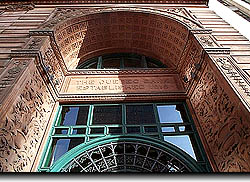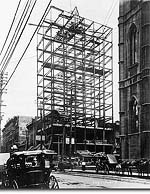| Skyscrapers since 1888
The entire history of Montréal skyscrapers is laid out around the place.
|
1888. The New York Life building, with its eight storeys served by an elevator and its clock tower, was Montréal's first skyscraper.
It deserves a closer look, if only to admire the skill of sculptor Henry Beaumont.

|
1911 and 1912. The Royal Trust and Duluth buildings represented a new generation of skyscrapers in Montréal. Thanks to its steel structure, the Duluth building reached the dizzying height of ten floors, the limit under Montréal by-laws until the 1920s. The stone-clad building recalls the three sections of a classical column, just like the Royal Trust building, with its base, shaft (repetitive intermediate floors) and capital. |
 |

